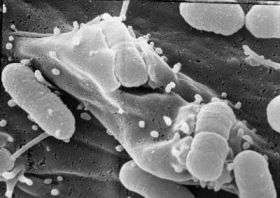Test of bacteria toxin delivery system could pave way for new antibiotic drugs

Researchers at the Hebrew University of Jerusalem have achieved a breakthrough in monitoring the toxin-delivery system of highly pathogenic bacteria – an accomplishment that could help pave the way for new drugs that will be capable of neutralizing those germs.
Most bacteria are harmless and do not cause infections. Some, however, are pathogenic and are equipped with special accessories that are used to deliver toxins (also termed "effectors") into the cells of the infected person.
Numerous bacteria that cause disease, ranging from food poisoning to life threatening infection, employ a syringe-like nano-organelle (a specialized part of a cell having a specific function) that is used to inject toxic effectors into attacked host cells. This process is termed a type III secretion system (TTSS). Among these pathogens are Salmonella; the cause of typhoid fever, Yersinia; and enteropathogenic (intestinal) E. coli, which is responsible for the death of up to one million infants per year, mostly in developing countries.
The bacterial syringe employed by these bacteria is an excellent potential target for drugs (not yet available) to combat these diseases. In order to develop such drugs, however, a better understanding of the syringe functions is needed, requiring development of better methods for measuring the syringe activity.
The Hebrew University researchers – Ilan Rosenshine, the Etta Rosensohn Professor of Bacteriology at the Hebrew University Faculty of Medicine, and his associates -- Erez Mills, Kobi Baruch, Xavier Charpentier and Simi Kobi -- have designed a new, real-time test that allows monitoring the syringe activity. Using this test, they have discovered new properties of this system, which might be used to develop drugs that will inhibit the syringe activity and thereby prevent disease and infection by these dangerous pathogens
Their achievement was described in a recent article in the journal Cell Host & Microbe.
Source: The Hebrew University of Jerusalem















